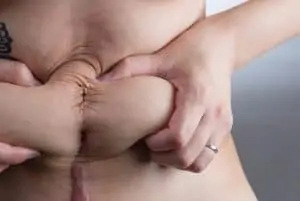Hey mamas! Have you heard of belly bands before? If not, you can read some of my previous posts about them.
For this post, though, I wanted to talk to you about how these garments can be helpful to you both during your pregnancy and soon following the delivery of your sweet baby.
- Belly band can minimize your pains and offer more support for your body.
- They can also be instrumental in your recovery after birth, especially from c-section deliveries.
- Learn how to get one that fits you just right and adjust it as your body changes.
What Are Belly Bands?
Belly bands are made from flexible yet supportive materials. They are designed to support your changing body by lending extra help to your abdomen and lower back.
And they have an incredible bounty of benefits for you while you’re pregnant and in that post-partum phase.
- Pain Relief
Yes, a belly band can help minimize your pain. As your pregnancy progresses, your growing belly strains your back and joints. It is painful! In fact, most mamas have low back pain and pain in the pelvic area during pregnancy.
So, wearing a belly band can help by taking the strain off these areas.
As you go through your pregnancy, you’re bound to experience what’s called SI joint pain (that’s sacroiliac, in case you were wondering), which is caused by relaxin, that hormone that continues to increase in your body during pregnancy. The purpose of this hormone is to make the hip joints loosen up for easier birthing, but it can make your other joints painful.
How so?
Well, it can bring sharp pains to your lower back and tailbone. A belly band adds stability to this joint and makes it much easier to go about your day.
In your second trimester, your ligaments may have more pain due to your growing belly. A belly band can redistribute that weight and reduce the pressure on this area, bringing you sweet, glorious relief.
- Compression
As your belly grows, it can be harder to do things you like. Even a simple walk can start to wear you down. Belly bands create gentle compression that supports you in your movements. The key is to make sure you are wearing it sparingly or having it too tight. This can make you more prone to things like indigestion and heartburn. Also, it could negatively impact your blood pressure.
- Help Your Posture
Towards the end of my first pregnancy and postpartum period, I had trouble maintaining my proper posture. Belly bands are excellent because they encourage you to hold it right without overextending your lower back. It was such a relief wearing mine, especially after that c-section. Your muscles are so weak in that recovery period, and having some assistance there help things even out.
- Get Exercise with Support
Unless your doctor has put you on bed rest, you should exercise daily while pregnant. It’s excellent for you and the baby since you’re building endurance while fighting off unfavorable conditions like diabetes or hypertension.
My friend Vicky had to stop exercising because she was so uncomfortable during her first pregnancy. I told her to talk to her doctor about a belly band, and she told me, “It was a game-changer! Thank you!” Thanks to using one, she was able to keep active again.
- Postpartum Support
And yes, as I mentioned, wearing one after you have the baby is great too. Your core strength is diminished, especially after a c-section. Even without one, though, you’ve got stretched-out muscles and ligaments. These all take time to heal, and it can be hard to help support these body parts correctly with caring for a new baby.
Wearing an apron belly band postpartum can keep you comfortable and lend more support as your body recovers. While it doesn’t fix everything and shouldn’t be worn ALL the time, it can be that essential assist when you are out and about. For example, you take the baby for fresh air or a walk, or to the park. That band can ensure you don’t pull anything and have the strength to lift your baby.
Tips for Wearing a Belly Band
While belly bands definitely help, you should limit wearing them to 2 to 3 hours at a time. You should also work on strengthening your core muscles through exercises once you’ve had your postpartum checkup.
If you have diastasis recti, read my posts on that and also talk to your doctor. You don’t want to make it worse. And speaking of talking to your doctor, please don’t just start wearing one of these belly bands without talking to them. We are all different, and I cannot possibly advise you if it is right for you without knowing your condition.
How to choose the right belly band and size?
Your belly band should be selected by measuring your belly at the biggest point around your abdomen. Generally, this will be across the belly button. Then you can pick the size that matches. If you want to buy one for after delivery, you should deduct about 3 or 5 inches from that measurement to get the right size.
Belly bands should be made from soft and adjustable materials. You do not want anything too constrictive. It should be able to expand and adjust with you. Try it on first to make sure it is comfortable when you wear it.
Never choose anything that chafes or makes you feel like a python is attacking you. A belly band should be comfortable when you wear it, but again, don’t get too comfortable. You don’t want or need to be wearing it 24/7.
Leslie Berry lives with her husband and two young daughters in Los Altos, California, where she loves helping other moms get comfortable with motherhood and embracing the insanity with facts peppered with laughs.
She loves eating too much sushi, exercising, and jamming out on her Fender. Read more about Leslie here.






